What is Iimp—Iimp of Class I SPD
impulse discharge current for class I test imp
The impulse discharge current passing through the device under test (SPD) is defined by the crest value Iimp, the charge Q and the specific energy W/R. The impulse current shall show no polarity reversal and shall reach Iimp within 50 µs. The transfer of the charge Q shall occur within 5 ms and the specific energy W/R shall be dissipated within 5 ms.
The impulse duration shall not exceed 5 ms
Preferred values of impulse discharge current Iimp for class I SPD Iimp:1,2,5,10, 12,5,20 and 25 kA
specific energy for class I test W/R
energy dissipated by a unit resistance of 1 Ώ with the impulse discharge current Iimp
NOTE:This is equal to the time integral of the square of the current (W/R = ∫ i 2 d t).
Q (As) and W/R (kJ/W) for given values of Iimp (kA).
Q = Iimp × a, where a = 5 × 10-4 s
W/R = Iimp2 x b, where b = 2.5 × 10-4 s
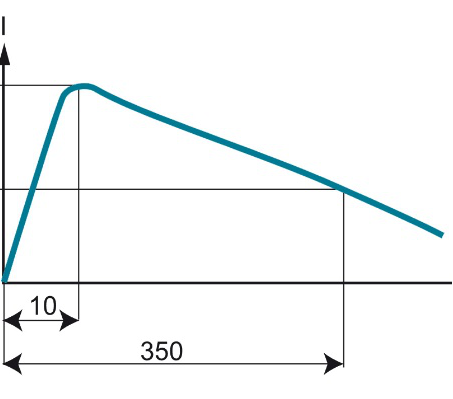
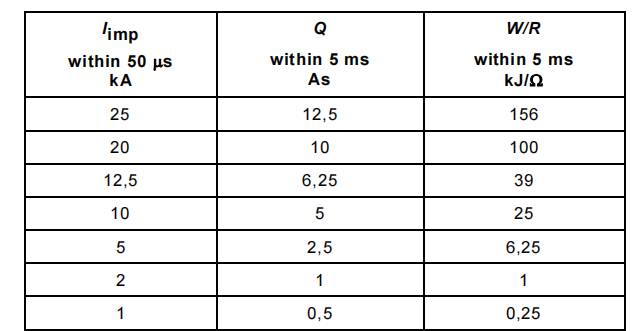
The IEC 62305 standard, defines “protection levels” as specific categories of lightning protection systems, each designed to provide a […]
Why you choose Prosurge– About PROSURGE SPD technology
①High energy MOV technology
Voltage limiting type SPD per IEC 61643
High energy AC/DC MOV is employed for PROSURGE’s class I, Class II and Class III AC/DC/PV SPD with compact size.
Advantage of MOV (Metal oxide varistor)
*Higher lightning & surge current discharge capacity
*Wide voltage range to cover AC/DC/PV application
*Fast response
*Wide working temperature
*No follow current in case of surge events
*End of life through thermal runaway, make thermal protection possible
*Stable performance in a long period time.
*Compact size
*Not influenced by various environmental factors while well encapsulated, especially suitable for application in higher altitude,offshore(e.g. offshore windfarms), dust, hot and moisture circumstances
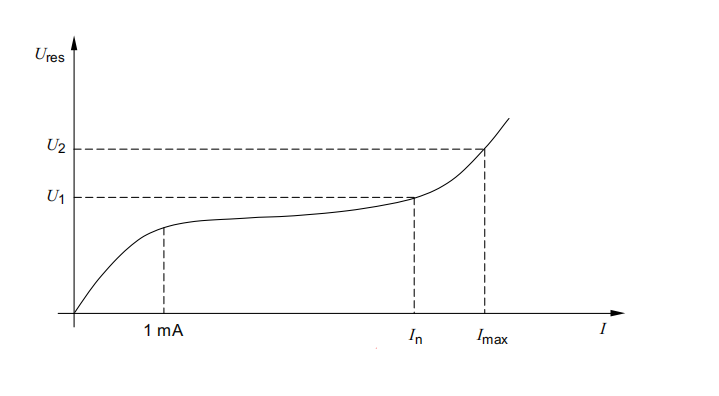
The heat generated by a MOV in end-of-life conditions can be sufficient to cause dangerous overheating of the SPD and even cause the SPD to catch fire.
To keep the SPD and system protected safe, thermal protection is used in all PROSURGE’s MOV type SPD
②PROSURGE patented thermal protection technology
√ Fast response to abnormal heat of MOV body
√ Surge withstand coordination with the SPD surge rating
√ Fast disconnect and cutoff the circuit in case of SPD failure
③PROSURGE patented arc-extinguish technology
Because of an arc between contact may happen while thermal disconnector open, even the arc current lasts for a short time, that […]
the selection and installation of photovoltaic surge protectors
Photovoltaic power generation is another renewable clean energy besides wind power generation, and is widely used in various countries and regions. It has the characteristics of simple installation, scalability, stability, and long life. Lightning strikes and surges are also a major disaster for photovoltaic power generation systems. Prosurge provides a comprehensive and efficient lightning protection solution for photovoltaic power generation systems.
PV installation with an external LPS when the separation distances is maintained (excluding multi-earthed solar systems, such as PV power plants)
Class II/T2 PV SPD is suggested to used at DC side of invertor

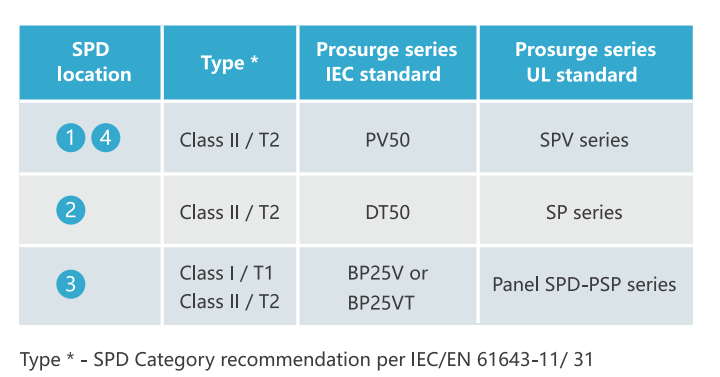
PV installation with an external LPS when the separation distances is maintained (excluding multi-earthed solar systems, such as PV power plants)
Class II/T2 PV SPD is suggested to used at DC side of invertor

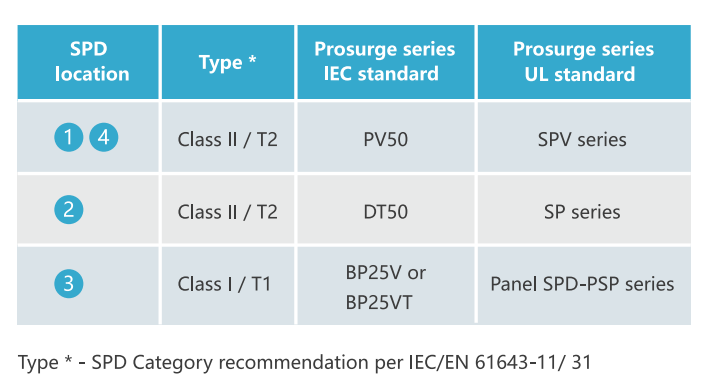
PV installation with an external LPS where the separation distances can not be maintained (including multi-earthed systems, such as PV power plants)
Class I/T1 PV SPD is suggested to used at DC side of invertor

Surge protective device – do you know its types?
Surge Protection Device (SPD) is an electronic device that provides safety protection for various electronic devices, instruments, and communication lines. It is suitable for power supply systems with AC 50/60Hz and rated voltage of 220V/380V. The types and structures of surge protectors vary according to their different uses, but they can generally be classified in the following ways:
一、 Classified by working principle
- Voltage switch type: It is in a high impedance state when there is no instantaneous overvoltage, and suddenly changes to a low impedance state when a surge occurs, effectively diverting the surge current to ground and protecting the equipment from overvoltage damage. Commonly used nonlinear components include discharge gaps, gas discharge tubes, thyristors, etc.
- Voltage limiting type: It exhibits a high impedance state when there is no surge, but as the surge current and voltage increase, the impedance will continuously decrease, limiting the voltage to a safe level. Its current voltage characteristics are strongly nonlinear, thus avoiding damage to equipment caused by overvoltage. Commonly used nonlinear components include zinc oxide, varistors, suppression diodes, avalanche diodes, etc.
- Combination type: Combining voltage switch type and voltage limiting type SPDs together, it has both voltage switch function […]
Do you know the Up value of surge protectors?
Surge protectors, as an important protective device, play a crucial role in protecting equipment from surge currents. When choosing a surge protector, an important parameter is the Up value. So, do you really understand the Up value of a surge protector?
Up: voltage protection level
parameter that characterizes the performance of the SPD in limiting the voltage across its terminals, which is selected from a list of preferred values. This value is greater than the highest value of the measured limiting voltages

After determining the limit of the Up value according to the national standard requirements, according to the standard specification 5.5.3.2 of GB/T 18802.12-2014 Selection and Use Guidelines for Surge Protective Devices in Low Voltage Distribution Systems, the Up value should be equal to or greater than the highest value of the measured limit voltage, and can be selected from the following preferred values:
Preferred values of voltage protection level Up (IEC61643-11)
0.08; 0.09; 0.10; 0.12; 0.15; 0.22; 0.33; 0.4; 0.5; 0.6; 0.7; 0.8; 0.9;
1.0; 1.2; 1.5; 1.8; 2.0; 2.5; 3.0; 4.0; 5.0; 6.0; 8.0 and 10 kV
A small Up value is beneficial for protecting equipment, but it is not necessarily better to have […]
Lightning protection and grounding knowledge popularization, take you to understand clearly in 2 minutes!
The grounding of lightning protection devices to prevent lightning overvoltage is usually referred to as lightning protection grounding. Lightning protection devices must have good grounding in order to effectively limit atmospheric overvoltage and scattered lightning currents. Below, the editor will popularize lightning protection and grounding knowledge for you, hoping to be helpful to you!
Lightning protection grounding map:
The lightning protection device consists of three parts: the lightning arrester (also known as the lightning receiving device. It is a metal rod that directly or indirectly receives lightning, such as lightning rods, lightning strips or lightning nets, as well as overhead ground wires), the down conductor (also known as the grounding wire. It is a metal conductor used to connect the lightning arrester to the grounding device), and the grounding device. The materials used for lightning protection devices should have sufficient mechanical strength and also meet the requirements of corrosion resistance.
In general, the material specifications selected according to these two principles can meet the requirements of dynamic stability and thermal stability when passing through lightning current. The so-called dynamic stability refers to the ability to resist the mechanical damage caused by lightning currents; The so-called thermal stability refers to the […]
The Importance of Surge Protection for Energy Storage Systems
Energy storage systems play a vital role in modern electricity grids, enabling the integration of renewable energy sources, improving grid stability, and providing backup power during outages. However, these systems are vulnerable to damage from power surges, which can occur due to lightning strikes, switching operations, or grid disturbances. Surge protection is essential for ensuring the safety, reliability, and longevity of energy storage systems.
Protecting Critical Components
Energy storage systems consist of various critical components, including batteries, inverters, control systems, and monitoring equipment. These components are sensitive to voltage spikes and can be damaged by power surges. For example, batteries are susceptible to thermal runaway and cell degradation if subjected to overvoltage. Inverters, which convert DC power from the batteries into AC power, can malfunction or fail if exposed to surges. Surge protection devices (SPDs) can safeguard these components by diverting excess voltage away from sensitive equipment.
Key Components Susceptible to Surge Damage
- Batteries:
- Vulnerable to overvoltage caused by external surges, which can lead to thermal runaway, electrolyte leakage, and cell degradation.
- Internal faults or short circuits within the battery system can also generate high current surges, damaging the battery cells.
- Inverters:
- Convert DC power from the batteries into AC power […]
Experimental Investigation of the Withstand Capability of Class I SPDs under 10/350μs and 8/20μs Impulse Currents
Surge protective devices (SPDs)are required to be tested under impulse discharge currents mainly with waveforms of 8/20 ms and 10/350 ms. However, with the improvement of SPD products, the performance and withstand capability of SPDs under such standard test currents need more investigation. In order to investigate and compare the withstand capability of SPDs under 8/20 ms and 10/350 ms impulse currents, experiments are carried out on three types of typical metal-oxide varistors (MOVs) that are used for class I SPDs. The results show that the MOVs with higher limiting voltage have better withstand capability under 8/20ms impulse current, while the conclusion under 10/350ms impulse current is opposite. Under 10/350 ms current, the MOV failure is related to the absorbed energy per unit volume under single impulse. Crack is the main damage form under 10/350ms current, which can be described as one side of the MOV plastic encapsulation and the electrode sheet peeling off. Ablation of the ZnO material, caused by the flashover between the electrode sheet and ZnO surface, appeared near the MOV electrode.
Surge protective devices (SPDs) connected to lowvoltage power systems, telecommunication and signal networks are required to be tested under requirements of IEC and IEEE […]
Introduction to Lightning Protection Zone (LPZ)
Lightning Protection Zone (LPZ)
In IEC standard, terms like type 1/2/3 or class 1/2/3 surge protective device is very popular. In this article, we are going to introduce a concept that is highly related to the previous terms: lightning protection zone or LPZ.
What is lightning protection zone and why does it matters?
The lightning protection zone concept is originated and described in the IEC 62305-4 standard which is an international stand for lightning protection. The LPZ concept is based on the idea of gradually reducing lightning energy to a safe level so that it won’t cause damage to terminal device.
Let’s see a basic illustration.
So what does the different lightning protection zone means?
LPZ 0A: It is a unprotected zone outside the building and it’s exposed to direct lightning strike. In LPZ 0A, there is no shielding against electromagnetic interference pulses LEMP (Lightning Electromagnetic Pulse).
LPZ 0B: Like LPZ 0A, it is also outside the building yet LPZ 0B are protected by the external lightning protection system, normally within the protection area of the lightning rod. Again, there is no shielding against LEMP too.
LPZ 1: It is the zone inside the building. At this zone, it is […]
Back-Up Protection Device for SPD – Circuit Breaker & Fuse
As we know, surge protective device will degrade or even come to end of life over time due to repeated small surges, a single strong surge or sustained overvoltage. And when surge protective device fails, it may create a short circuit condition and cause safety problem in the power system. Thus proper overcurrent protection device is needed to work together with surge protective device.
There are normally two types of overcurrent protection device that used together with SPD for backup protection: circuit breaker and fuse. So, what are their Pros and Cons respectively?
Circuit Breaker
Advantages
- Can be repeatedly used and thus lower the maintenance cost.
Disadvantages
- Have a greater voltage drop when experiencing surge current and thus will lower the SPD’s protection level
Fuse
Advantages
- Less likely to malfunction
- Lower voltage drop at surge current
- The product itself is more cost effective especially for great short circuit current situation
Disadvantages
- After it functions, the fuse has to be replaced and thus increase maintenance cost
So in practice, both devices are used depending on the specific situation.
